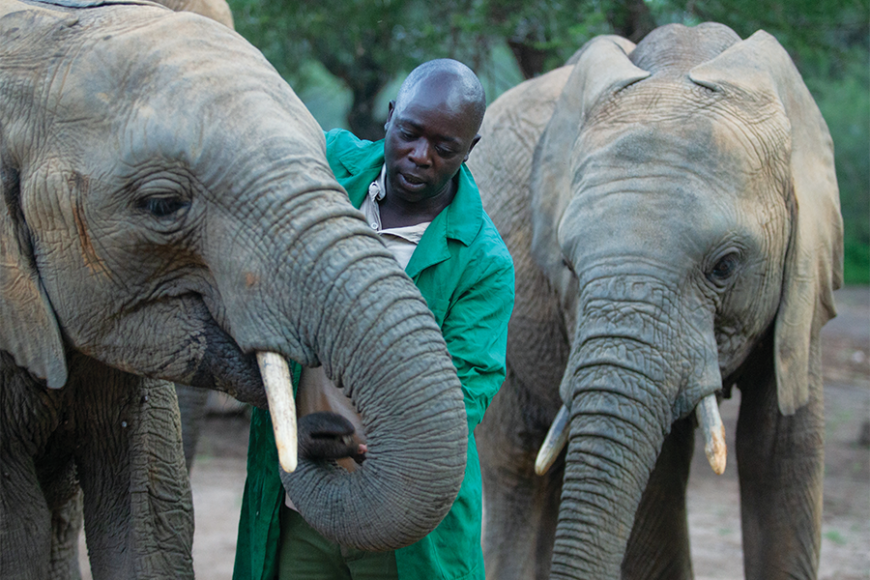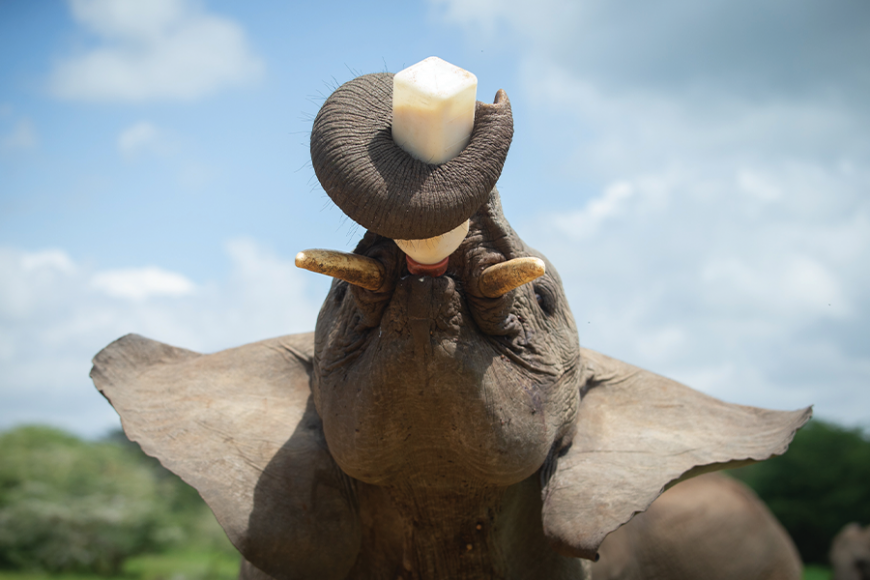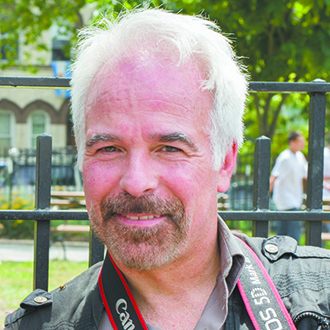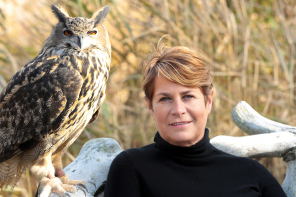“Offering a haven so rescued animals can heal and join a family.”
— Sheldrick Wildlife Trust
Oliver Twist is the person I think of whenever I hear the word “orphan” and pity is the emotion it brings. However, lucky orphan elephants, rhinoceroses and giraffes are being cared for by one of the most successful rescue programs in the world, the Sheldrick Wildlife Trust. David Sheldrick was the founding warden of Tsavo National Park in Kenya and a wildlife conservation pioneer who died in 1977. Before his death, he and his wife, Daphne, had worked together to create the infrastructure to preserve elephants and black rhinos in this sprawling, untamed preserve of more than 8,000 square miles that was formerly the Taru desert.
Daphne would continue his legacy and build a small home in Nairobi National Park, around which has grown the Sheldrick Wildlife Trust elephant and rhino orphanage. It was in Nairobi that Daphne ultimately fine-tuned the milk formula and husbandry needed to hand-raise baby elephants successfully, knowledge that has gone on to save the lives of hundreds of elephants, not only in Kenya, but across Africa and into India, Myanmar and beyond. She helped people better understand these giants and their incredible capacity for love and forgiveness.
While it’s true that they have all endured traumatic experiences, either from poaching, drought or human-wildlife conflict, they are watched over and nurtured once rescued to ensure they can return to their lives as wild elephants.
The program at Umani Springs — located in the Kibwezi Forest within the Tsavo Conservation Area — is not for babies but older elephants who are ready to make the transition. It’s a slow process, one that involves a gradual reintroduction back into the wild. During this time, they are given milk three times a day and forage during daily supervised trips into the bush. With no ex-orphan herds to learn from, the interactions with wild herds is critical to helping them transition. The keepers try to stand back to allow the orphans to socialize with the wild elephants, conscious of the fact their scent could frighten them.
Family is everything in the world of elephants. When the elephants first arrive here, they need to form new relationships with the other elephants. Sonje and Murera are two of the older females at Umani Springs. Before being rescued, Sonje’s right hind leg had been hit with a spear and over time the wound festered, creating a huge protusion on her joint when she was found. She was too weak and lame to resist when rescued. Murera was found severely lame after falling onto poison spikes, which had been placed in the bottom of a hole that had been concealed and covered with grasses. Now recovered at Umani Springs and with maternal instincts, they both dote upon the youngsters Mwashoti and Alamaya. Mwashoti had a horrendous snare wound that cut through his leg joint. When found, the difficult decision was made to separate him from his mother since they were both deteriorating because of the injury and neither would survive without help. Alamaya had already been ravaged by hyenas when rescued. His genitals and tail were bitten off and surgery was needed to allow him to urinate.
Founded in 2014, Umani Springs has abundant food and water throughout the year. This location was chosen because it ensures the elephants do not have to travel huge distances to find food and can remain within this beautiful ecosystem year-round. There’s also an exclusive bush camp for tourism called Umani Springs Lodge that can accommodate 10 guests, with sponsorship of an orphan required before arrival.
The keepers live nearby on the grounds, just a few minutes walk from the elephant compound enclosures. Most of the elephants return each night to sleep inside, although, depending on their transition progress, a few are allowed to remain in the bush at night, returning in the morning for their bottles. After eating, they will congregate together to socialize with one another and with human visitors, too.
According to the main keeper, Philip, the work can be sometimes dangerous, as when Sonje brought a wild friend back to her enclosure one night. The wild elephant did not understand the relationship between humans and the orphans and reacted with hostility. Although they were able to manage the situation, it is important to understand the seriousness of working with animals that have often been referred to as “nature’s bulldozers.” Philip also told me about the incredible joy the keepers have experienced when the now wild-living orphan females breed and return to visit with their wild babies. The number of babies born into the wild by orphans raised by the trust is 30. In addition, there are 156 orphans living wild with many nearing breeding age.
According to the Sheldrick Wildlife Trust 2018 Newsletter, the goal is “Alleviating animal suffering, preventing poaching, saving the lives of wild orphans and sharing in the joy of the next generation born to those raised from infancy.”
For more, visit sheldrickwildlifetrust.org and for more on John’s photographic tours, visit africaphototours.com and jrizzophoto.com.






